Evaluating Rainwater Harvesting in Sydney: Design and Sustainability
VerifiedAdded on 2023/03/23
|41
|14377
|97
Literature Review
AI Summary
This document presents a literature review on rainwater harvesting in Sydney, Australia, addressing water scarcity issues and evaluating rainwater harvesting systems (RWHS) as a sustainable solution. It covers the background of water scarcity, the advantages and disadvantages of RWHS, factors affecting its adoption, and design considerations. The review also examines rainwater harvesting practices in different global cities, relevant research in Australia and specifically in Sydney, and introduces the e-Tank daily water balance model. The study highlights the importance of using actual rainfall and water consumption data for accurate RWHS design, aiming to overcome the limitations of previous studies that relied on historical data. The research objectives include investigating climate variability and water demand trends, estimating rainwater collection potential, analyzing feasibility and reliability, determining the optimal design of RWHS, and calculating the payback period for such systems in Sydney.
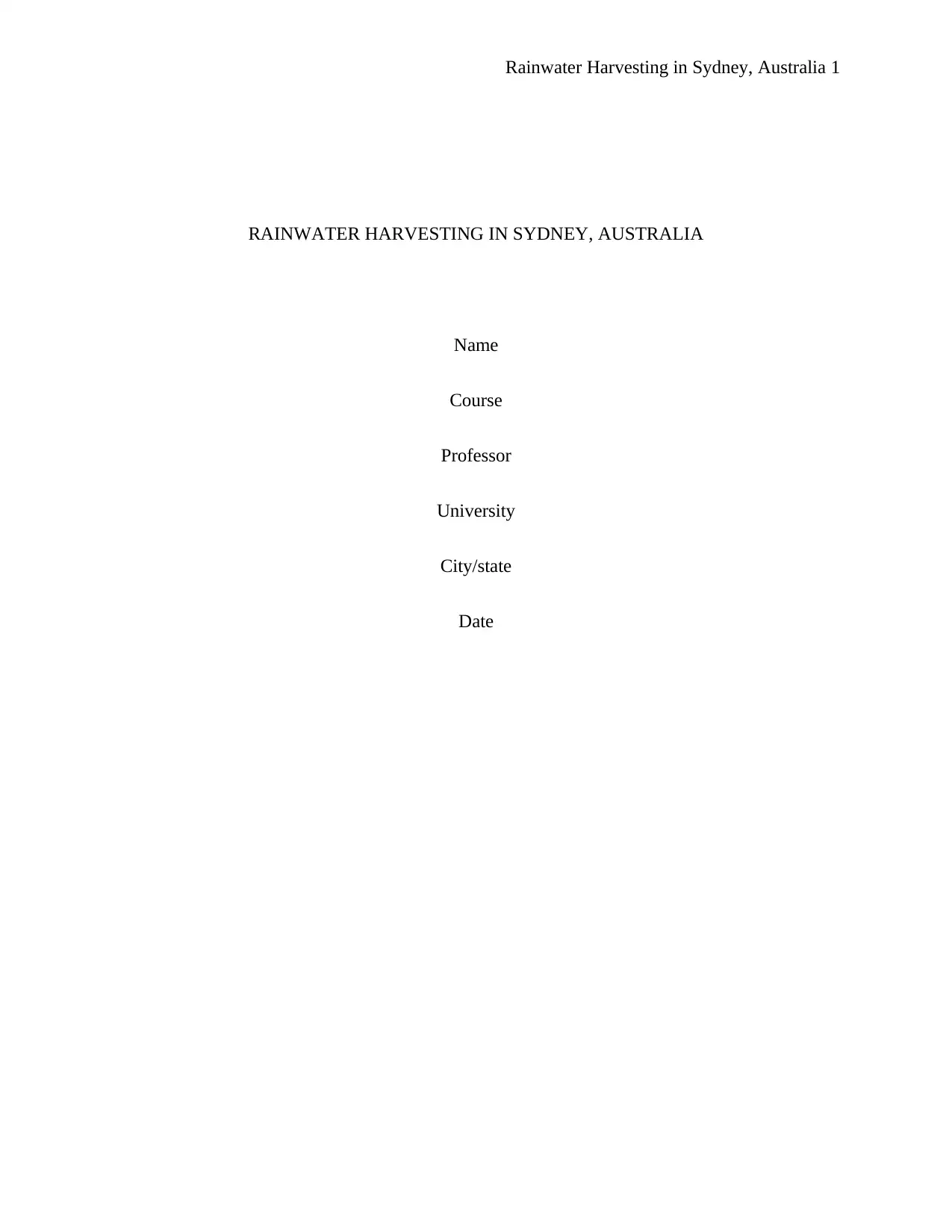
Rainwater Harvesting in Sydney, Australia 1
RAINWATER HARVESTING IN SYDNEY, AUSTRALIA
Name
Course
Professor
University
City/state
Date
RAINWATER HARVESTING IN SYDNEY, AUSTRALIA
Name
Course
Professor
University
City/state
Date
Paraphrase This Document
Need a fresh take? Get an instant paraphrase of this document with our AI Paraphraser
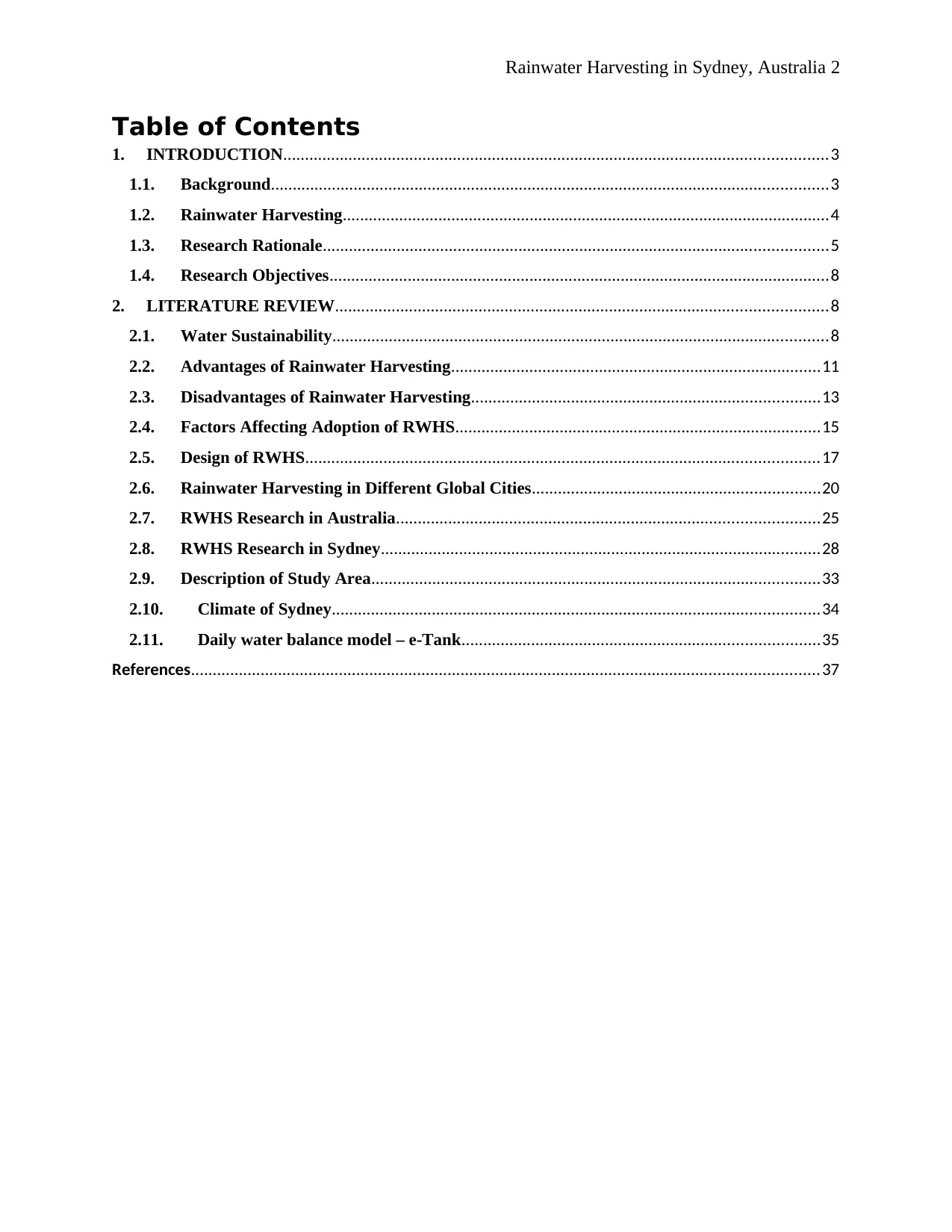
Rainwater Harvesting in Sydney, Australia 2
Table of Contents
1. INTRODUCTION.............................................................................................................................3
1.1. Background................................................................................................................................3
1.2. Rainwater Harvesting................................................................................................................4
1.3. Research Rationale....................................................................................................................5
1.4. Research Objectives...................................................................................................................8
2. LITERATURE REVIEW.................................................................................................................8
2.1. Water Sustainability..................................................................................................................8
2.2. Advantages of Rainwater Harvesting.....................................................................................11
2.3. Disadvantages of Rainwater Harvesting................................................................................13
2.4. Factors Affecting Adoption of RWHS....................................................................................15
2.5. Design of RWHS......................................................................................................................17
2.6. Rainwater Harvesting in Different Global Cities..................................................................20
2.7. RWHS Research in Australia.................................................................................................25
2.8. RWHS Research in Sydney.....................................................................................................28
2.9. Description of Study Area.......................................................................................................33
2.10. Climate of Sydney................................................................................................................34
2.11. Daily water balance model – e-Tank..................................................................................35
References................................................................................................................................................37
Table of Contents
1. INTRODUCTION.............................................................................................................................3
1.1. Background................................................................................................................................3
1.2. Rainwater Harvesting................................................................................................................4
1.3. Research Rationale....................................................................................................................5
1.4. Research Objectives...................................................................................................................8
2. LITERATURE REVIEW.................................................................................................................8
2.1. Water Sustainability..................................................................................................................8
2.2. Advantages of Rainwater Harvesting.....................................................................................11
2.3. Disadvantages of Rainwater Harvesting................................................................................13
2.4. Factors Affecting Adoption of RWHS....................................................................................15
2.5. Design of RWHS......................................................................................................................17
2.6. Rainwater Harvesting in Different Global Cities..................................................................20
2.7. RWHS Research in Australia.................................................................................................25
2.8. RWHS Research in Sydney.....................................................................................................28
2.9. Description of Study Area.......................................................................................................33
2.10. Climate of Sydney................................................................................................................34
2.11. Daily water balance model – e-Tank..................................................................................35
References................................................................................................................................................37
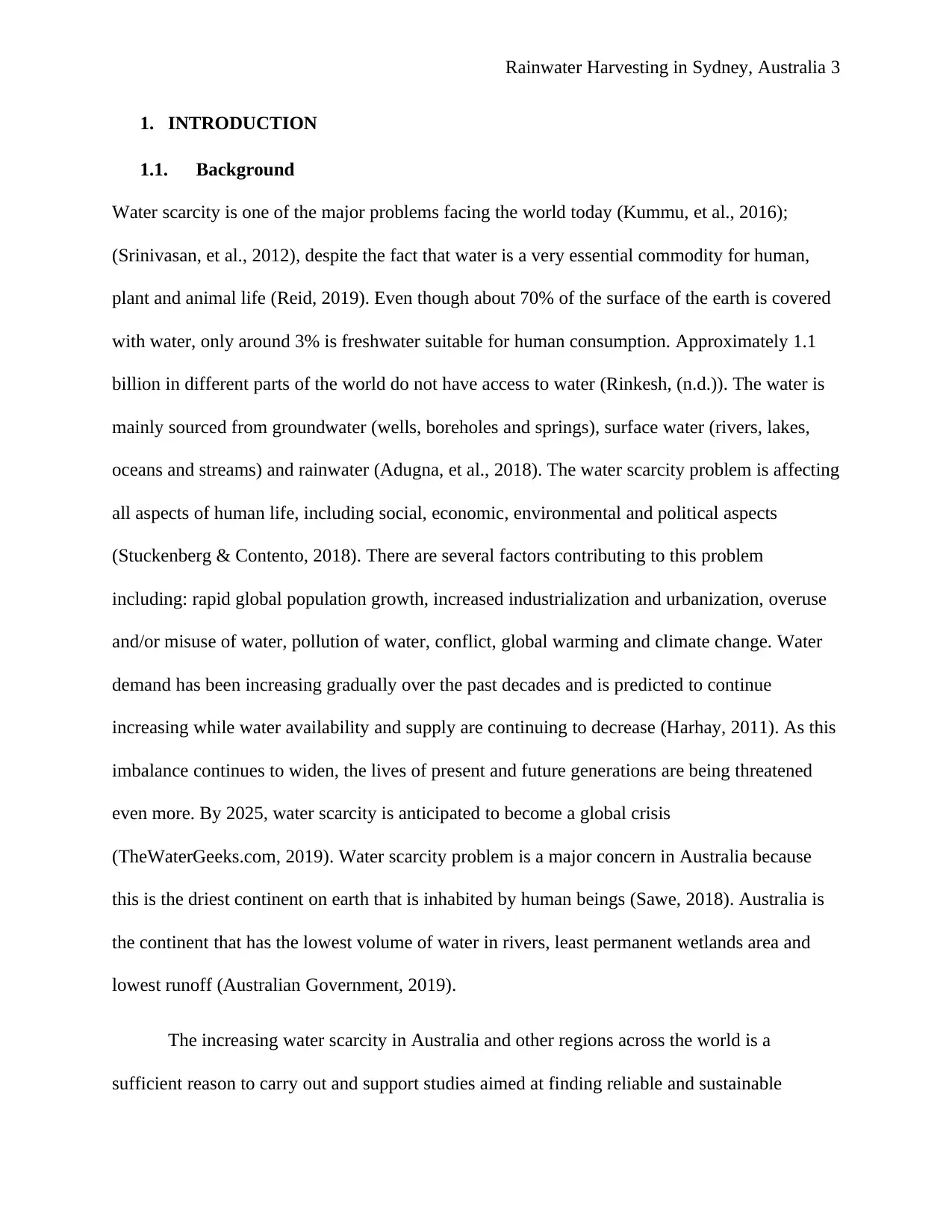
Rainwater Harvesting in Sydney, Australia 3
1. INTRODUCTION
1.1. Background
Water scarcity is one of the major problems facing the world today (Kummu, et al., 2016);
(Srinivasan, et al., 2012), despite the fact that water is a very essential commodity for human,
plant and animal life (Reid, 2019). Even though about 70% of the surface of the earth is covered
with water, only around 3% is freshwater suitable for human consumption. Approximately 1.1
billion in different parts of the world do not have access to water (Rinkesh, (n.d.)). The water is
mainly sourced from groundwater (wells, boreholes and springs), surface water (rivers, lakes,
oceans and streams) and rainwater (Adugna, et al., 2018). The water scarcity problem is affecting
all aspects of human life, including social, economic, environmental and political aspects
(Stuckenberg & Contento, 2018). There are several factors contributing to this problem
including: rapid global population growth, increased industrialization and urbanization, overuse
and/or misuse of water, pollution of water, conflict, global warming and climate change. Water
demand has been increasing gradually over the past decades and is predicted to continue
increasing while water availability and supply are continuing to decrease (Harhay, 2011). As this
imbalance continues to widen, the lives of present and future generations are being threatened
even more. By 2025, water scarcity is anticipated to become a global crisis
(TheWaterGeeks.com, 2019). Water scarcity problem is a major concern in Australia because
this is the driest continent on earth that is inhabited by human beings (Sawe, 2018). Australia is
the continent that has the lowest volume of water in rivers, least permanent wetlands area and
lowest runoff (Australian Government, 2019).
The increasing water scarcity in Australia and other regions across the world is a
sufficient reason to carry out and support studies aimed at finding reliable and sustainable
1. INTRODUCTION
1.1. Background
Water scarcity is one of the major problems facing the world today (Kummu, et al., 2016);
(Srinivasan, et al., 2012), despite the fact that water is a very essential commodity for human,
plant and animal life (Reid, 2019). Even though about 70% of the surface of the earth is covered
with water, only around 3% is freshwater suitable for human consumption. Approximately 1.1
billion in different parts of the world do not have access to water (Rinkesh, (n.d.)). The water is
mainly sourced from groundwater (wells, boreholes and springs), surface water (rivers, lakes,
oceans and streams) and rainwater (Adugna, et al., 2018). The water scarcity problem is affecting
all aspects of human life, including social, economic, environmental and political aspects
(Stuckenberg & Contento, 2018). There are several factors contributing to this problem
including: rapid global population growth, increased industrialization and urbanization, overuse
and/or misuse of water, pollution of water, conflict, global warming and climate change. Water
demand has been increasing gradually over the past decades and is predicted to continue
increasing while water availability and supply are continuing to decrease (Harhay, 2011). As this
imbalance continues to widen, the lives of present and future generations are being threatened
even more. By 2025, water scarcity is anticipated to become a global crisis
(TheWaterGeeks.com, 2019). Water scarcity problem is a major concern in Australia because
this is the driest continent on earth that is inhabited by human beings (Sawe, 2018). Australia is
the continent that has the lowest volume of water in rivers, least permanent wetlands area and
lowest runoff (Australian Government, 2019).
The increasing water scarcity in Australia and other regions across the world is a
sufficient reason to carry out and support studies aimed at finding reliable and sustainable
⊘ This is a preview!⊘
Do you want full access?
Subscribe today to unlock all pages.

Trusted by 1+ million students worldwide
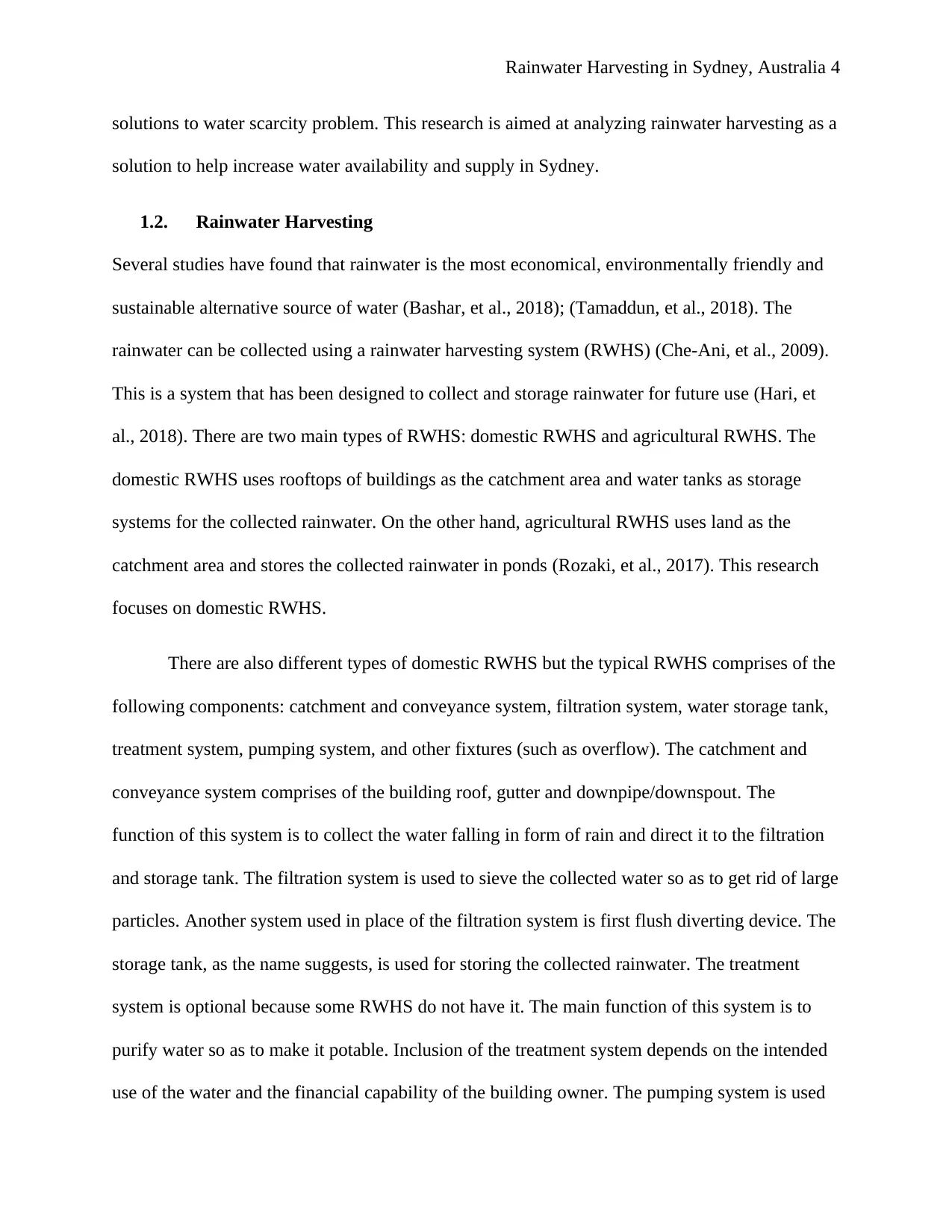
Rainwater Harvesting in Sydney, Australia 4
solutions to water scarcity problem. This research is aimed at analyzing rainwater harvesting as a
solution to help increase water availability and supply in Sydney.
1.2. Rainwater Harvesting
Several studies have found that rainwater is the most economical, environmentally friendly and
sustainable alternative source of water (Bashar, et al., 2018); (Tamaddun, et al., 2018). The
rainwater can be collected using a rainwater harvesting system (RWHS) (Che-Ani, et al., 2009).
This is a system that has been designed to collect and storage rainwater for future use (Hari, et
al., 2018). There are two main types of RWHS: domestic RWHS and agricultural RWHS. The
domestic RWHS uses rooftops of buildings as the catchment area and water tanks as storage
systems for the collected rainwater. On the other hand, agricultural RWHS uses land as the
catchment area and stores the collected rainwater in ponds (Rozaki, et al., 2017). This research
focuses on domestic RWHS.
There are also different types of domestic RWHS but the typical RWHS comprises of the
following components: catchment and conveyance system, filtration system, water storage tank,
treatment system, pumping system, and other fixtures (such as overflow). The catchment and
conveyance system comprises of the building roof, gutter and downpipe/downspout. The
function of this system is to collect the water falling in form of rain and direct it to the filtration
and storage tank. The filtration system is used to sieve the collected water so as to get rid of large
particles. Another system used in place of the filtration system is first flush diverting device. The
storage tank, as the name suggests, is used for storing the collected rainwater. The treatment
system is optional because some RWHS do not have it. The main function of this system is to
purify water so as to make it potable. Inclusion of the treatment system depends on the intended
use of the water and the financial capability of the building owner. The pumping system is used
solutions to water scarcity problem. This research is aimed at analyzing rainwater harvesting as a
solution to help increase water availability and supply in Sydney.
1.2. Rainwater Harvesting
Several studies have found that rainwater is the most economical, environmentally friendly and
sustainable alternative source of water (Bashar, et al., 2018); (Tamaddun, et al., 2018). The
rainwater can be collected using a rainwater harvesting system (RWHS) (Che-Ani, et al., 2009).
This is a system that has been designed to collect and storage rainwater for future use (Hari, et
al., 2018). There are two main types of RWHS: domestic RWHS and agricultural RWHS. The
domestic RWHS uses rooftops of buildings as the catchment area and water tanks as storage
systems for the collected rainwater. On the other hand, agricultural RWHS uses land as the
catchment area and stores the collected rainwater in ponds (Rozaki, et al., 2017). This research
focuses on domestic RWHS.
There are also different types of domestic RWHS but the typical RWHS comprises of the
following components: catchment and conveyance system, filtration system, water storage tank,
treatment system, pumping system, and other fixtures (such as overflow). The catchment and
conveyance system comprises of the building roof, gutter and downpipe/downspout. The
function of this system is to collect the water falling in form of rain and direct it to the filtration
and storage tank. The filtration system is used to sieve the collected water so as to get rid of large
particles. Another system used in place of the filtration system is first flush diverting device. The
storage tank, as the name suggests, is used for storing the collected rainwater. The treatment
system is optional because some RWHS do not have it. The main function of this system is to
purify water so as to make it potable. Inclusion of the treatment system depends on the intended
use of the water and the financial capability of the building owner. The pumping system is used
Paraphrase This Document
Need a fresh take? Get an instant paraphrase of this document with our AI Paraphraser
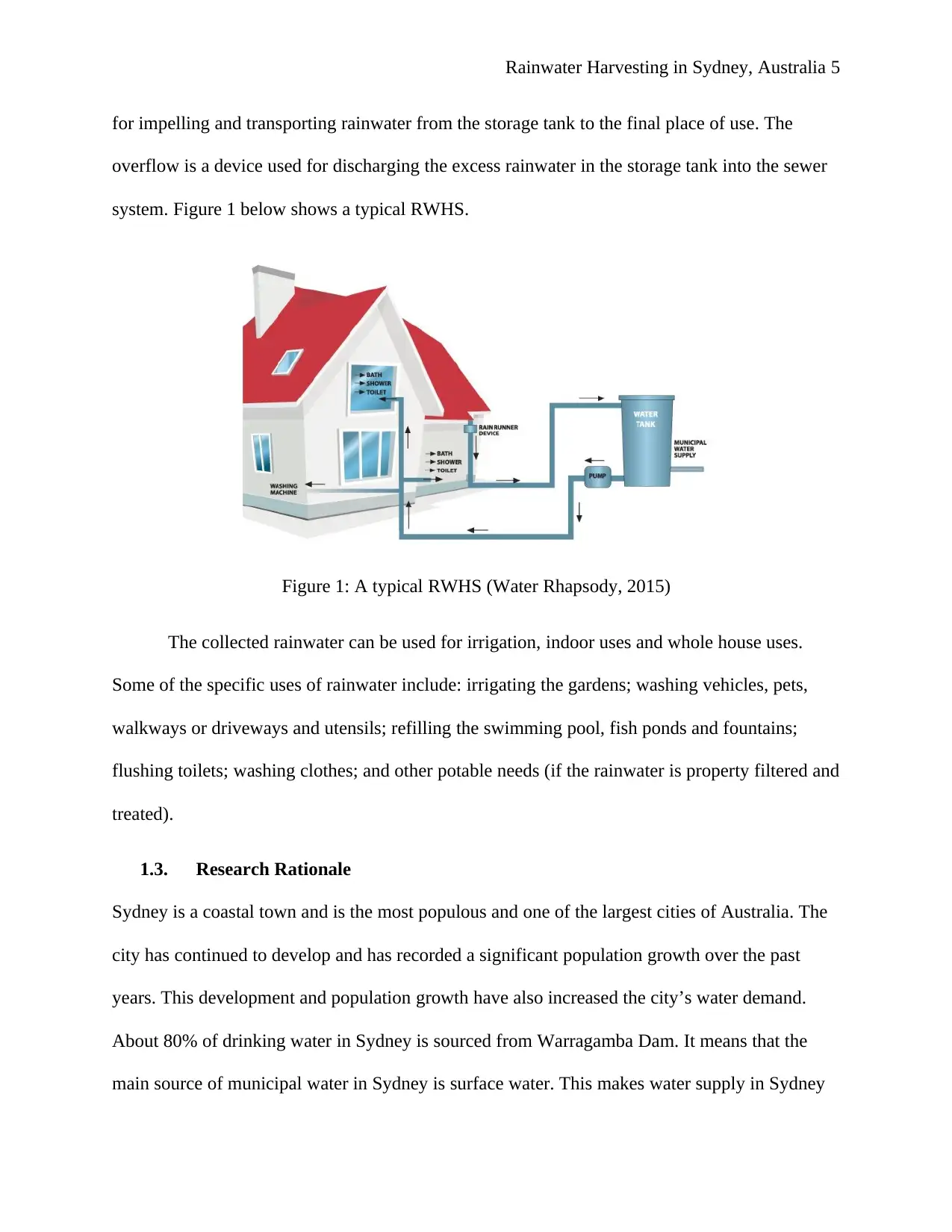
Rainwater Harvesting in Sydney, Australia 5
for impelling and transporting rainwater from the storage tank to the final place of use. The
overflow is a device used for discharging the excess rainwater in the storage tank into the sewer
system. Figure 1 below shows a typical RWHS.
Figure 1: A typical RWHS (Water Rhapsody, 2015)
The collected rainwater can be used for irrigation, indoor uses and whole house uses.
Some of the specific uses of rainwater include: irrigating the gardens; washing vehicles, pets,
walkways or driveways and utensils; refilling the swimming pool, fish ponds and fountains;
flushing toilets; washing clothes; and other potable needs (if the rainwater is property filtered and
treated).
1.3. Research Rationale
Sydney is a coastal town and is the most populous and one of the largest cities of Australia. The
city has continued to develop and has recorded a significant population growth over the past
years. This development and population growth have also increased the city’s water demand.
About 80% of drinking water in Sydney is sourced from Warragamba Dam. It means that the
main source of municipal water in Sydney is surface water. This makes water supply in Sydney
for impelling and transporting rainwater from the storage tank to the final place of use. The
overflow is a device used for discharging the excess rainwater in the storage tank into the sewer
system. Figure 1 below shows a typical RWHS.
Figure 1: A typical RWHS (Water Rhapsody, 2015)
The collected rainwater can be used for irrigation, indoor uses and whole house uses.
Some of the specific uses of rainwater include: irrigating the gardens; washing vehicles, pets,
walkways or driveways and utensils; refilling the swimming pool, fish ponds and fountains;
flushing toilets; washing clothes; and other potable needs (if the rainwater is property filtered and
treated).
1.3. Research Rationale
Sydney is a coastal town and is the most populous and one of the largest cities of Australia. The
city has continued to develop and has recorded a significant population growth over the past
years. This development and population growth have also increased the city’s water demand.
About 80% of drinking water in Sydney is sourced from Warragamba Dam. It means that the
main source of municipal water in Sydney is surface water. This makes water supply in Sydney
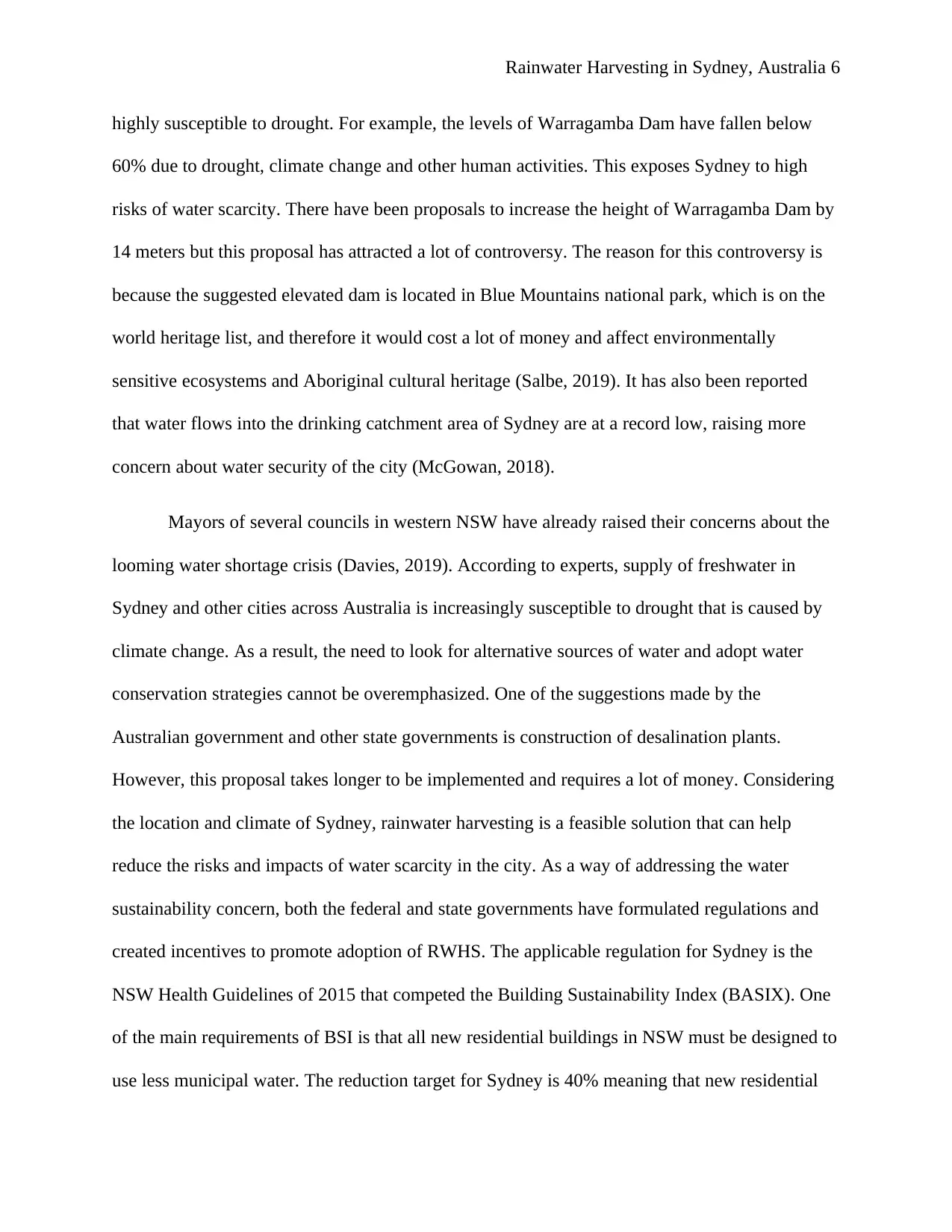
Rainwater Harvesting in Sydney, Australia 6
highly susceptible to drought. For example, the levels of Warragamba Dam have fallen below
60% due to drought, climate change and other human activities. This exposes Sydney to high
risks of water scarcity. There have been proposals to increase the height of Warragamba Dam by
14 meters but this proposal has attracted a lot of controversy. The reason for this controversy is
because the suggested elevated dam is located in Blue Mountains national park, which is on the
world heritage list, and therefore it would cost a lot of money and affect environmentally
sensitive ecosystems and Aboriginal cultural heritage (Salbe, 2019). It has also been reported
that water flows into the drinking catchment area of Sydney are at a record low, raising more
concern about water security of the city (McGowan, 2018).
Mayors of several councils in western NSW have already raised their concerns about the
looming water shortage crisis (Davies, 2019). According to experts, supply of freshwater in
Sydney and other cities across Australia is increasingly susceptible to drought that is caused by
climate change. As a result, the need to look for alternative sources of water and adopt water
conservation strategies cannot be overemphasized. One of the suggestions made by the
Australian government and other state governments is construction of desalination plants.
However, this proposal takes longer to be implemented and requires a lot of money. Considering
the location and climate of Sydney, rainwater harvesting is a feasible solution that can help
reduce the risks and impacts of water scarcity in the city. As a way of addressing the water
sustainability concern, both the federal and state governments have formulated regulations and
created incentives to promote adoption of RWHS. The applicable regulation for Sydney is the
NSW Health Guidelines of 2015 that competed the Building Sustainability Index (BASIX). One
of the main requirements of BSI is that all new residential buildings in NSW must be designed to
use less municipal water. The reduction target for Sydney is 40% meaning that new residential
highly susceptible to drought. For example, the levels of Warragamba Dam have fallen below
60% due to drought, climate change and other human activities. This exposes Sydney to high
risks of water scarcity. There have been proposals to increase the height of Warragamba Dam by
14 meters but this proposal has attracted a lot of controversy. The reason for this controversy is
because the suggested elevated dam is located in Blue Mountains national park, which is on the
world heritage list, and therefore it would cost a lot of money and affect environmentally
sensitive ecosystems and Aboriginal cultural heritage (Salbe, 2019). It has also been reported
that water flows into the drinking catchment area of Sydney are at a record low, raising more
concern about water security of the city (McGowan, 2018).
Mayors of several councils in western NSW have already raised their concerns about the
looming water shortage crisis (Davies, 2019). According to experts, supply of freshwater in
Sydney and other cities across Australia is increasingly susceptible to drought that is caused by
climate change. As a result, the need to look for alternative sources of water and adopt water
conservation strategies cannot be overemphasized. One of the suggestions made by the
Australian government and other state governments is construction of desalination plants.
However, this proposal takes longer to be implemented and requires a lot of money. Considering
the location and climate of Sydney, rainwater harvesting is a feasible solution that can help
reduce the risks and impacts of water scarcity in the city. As a way of addressing the water
sustainability concern, both the federal and state governments have formulated regulations and
created incentives to promote adoption of RWHS. The applicable regulation for Sydney is the
NSW Health Guidelines of 2015 that competed the Building Sustainability Index (BASIX). One
of the main requirements of BSI is that all new residential buildings in NSW must be designed to
use less municipal water. The reduction target for Sydney is 40% meaning that new residential
⊘ This is a preview!⊘
Do you want full access?
Subscribe today to unlock all pages.

Trusted by 1+ million students worldwide
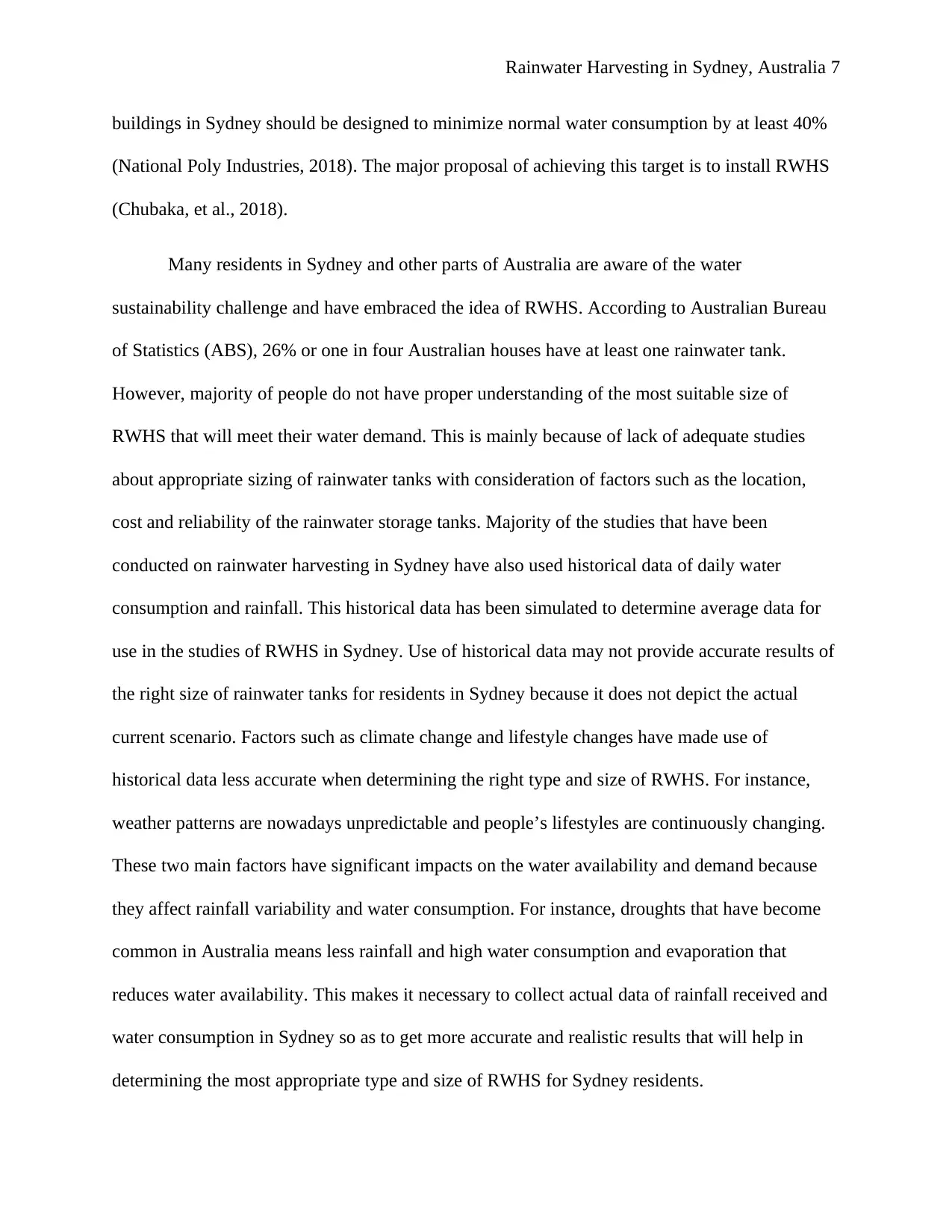
Rainwater Harvesting in Sydney, Australia 7
buildings in Sydney should be designed to minimize normal water consumption by at least 40%
(National Poly Industries, 2018). The major proposal of achieving this target is to install RWHS
(Chubaka, et al., 2018).
Many residents in Sydney and other parts of Australia are aware of the water
sustainability challenge and have embraced the idea of RWHS. According to Australian Bureau
of Statistics (ABS), 26% or one in four Australian houses have at least one rainwater tank.
However, majority of people do not have proper understanding of the most suitable size of
RWHS that will meet their water demand. This is mainly because of lack of adequate studies
about appropriate sizing of rainwater tanks with consideration of factors such as the location,
cost and reliability of the rainwater storage tanks. Majority of the studies that have been
conducted on rainwater harvesting in Sydney have also used historical data of daily water
consumption and rainfall. This historical data has been simulated to determine average data for
use in the studies of RWHS in Sydney. Use of historical data may not provide accurate results of
the right size of rainwater tanks for residents in Sydney because it does not depict the actual
current scenario. Factors such as climate change and lifestyle changes have made use of
historical data less accurate when determining the right type and size of RWHS. For instance,
weather patterns are nowadays unpredictable and people’s lifestyles are continuously changing.
These two main factors have significant impacts on the water availability and demand because
they affect rainfall variability and water consumption. For instance, droughts that have become
common in Australia means less rainfall and high water consumption and evaporation that
reduces water availability. This makes it necessary to collect actual data of rainfall received and
water consumption in Sydney so as to get more accurate and realistic results that will help in
determining the most appropriate type and size of RWHS for Sydney residents.
buildings in Sydney should be designed to minimize normal water consumption by at least 40%
(National Poly Industries, 2018). The major proposal of achieving this target is to install RWHS
(Chubaka, et al., 2018).
Many residents in Sydney and other parts of Australia are aware of the water
sustainability challenge and have embraced the idea of RWHS. According to Australian Bureau
of Statistics (ABS), 26% or one in four Australian houses have at least one rainwater tank.
However, majority of people do not have proper understanding of the most suitable size of
RWHS that will meet their water demand. This is mainly because of lack of adequate studies
about appropriate sizing of rainwater tanks with consideration of factors such as the location,
cost and reliability of the rainwater storage tanks. Majority of the studies that have been
conducted on rainwater harvesting in Sydney have also used historical data of daily water
consumption and rainfall. This historical data has been simulated to determine average data for
use in the studies of RWHS in Sydney. Use of historical data may not provide accurate results of
the right size of rainwater tanks for residents in Sydney because it does not depict the actual
current scenario. Factors such as climate change and lifestyle changes have made use of
historical data less accurate when determining the right type and size of RWHS. For instance,
weather patterns are nowadays unpredictable and people’s lifestyles are continuously changing.
These two main factors have significant impacts on the water availability and demand because
they affect rainfall variability and water consumption. For instance, droughts that have become
common in Australia means less rainfall and high water consumption and evaporation that
reduces water availability. This makes it necessary to collect actual data of rainfall received and
water consumption in Sydney so as to get more accurate and realistic results that will help in
determining the most appropriate type and size of RWHS for Sydney residents.
Paraphrase This Document
Need a fresh take? Get an instant paraphrase of this document with our AI Paraphraser
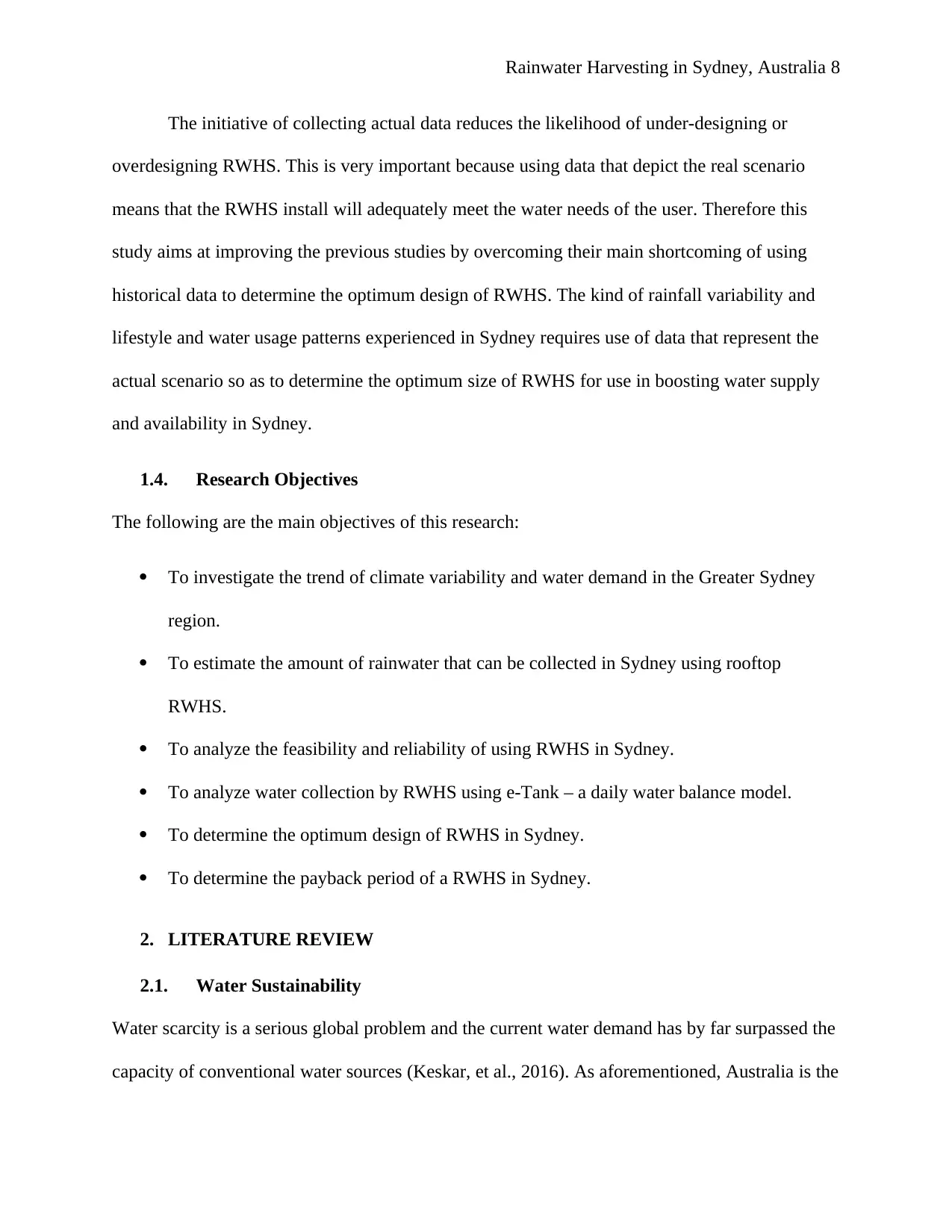
Rainwater Harvesting in Sydney, Australia 8
The initiative of collecting actual data reduces the likelihood of under-designing or
overdesigning RWHS. This is very important because using data that depict the real scenario
means that the RWHS install will adequately meet the water needs of the user. Therefore this
study aims at improving the previous studies by overcoming their main shortcoming of using
historical data to determine the optimum design of RWHS. The kind of rainfall variability and
lifestyle and water usage patterns experienced in Sydney requires use of data that represent the
actual scenario so as to determine the optimum size of RWHS for use in boosting water supply
and availability in Sydney.
1.4. Research Objectives
The following are the main objectives of this research:
To investigate the trend of climate variability and water demand in the Greater Sydney
region.
To estimate the amount of rainwater that can be collected in Sydney using rooftop
RWHS.
To analyze the feasibility and reliability of using RWHS in Sydney.
To analyze water collection by RWHS using e-Tank – a daily water balance model.
To determine the optimum design of RWHS in Sydney.
To determine the payback period of a RWHS in Sydney.
2. LITERATURE REVIEW
2.1. Water Sustainability
Water scarcity is a serious global problem and the current water demand has by far surpassed the
capacity of conventional water sources (Keskar, et al., 2016). As aforementioned, Australia is the
The initiative of collecting actual data reduces the likelihood of under-designing or
overdesigning RWHS. This is very important because using data that depict the real scenario
means that the RWHS install will adequately meet the water needs of the user. Therefore this
study aims at improving the previous studies by overcoming their main shortcoming of using
historical data to determine the optimum design of RWHS. The kind of rainfall variability and
lifestyle and water usage patterns experienced in Sydney requires use of data that represent the
actual scenario so as to determine the optimum size of RWHS for use in boosting water supply
and availability in Sydney.
1.4. Research Objectives
The following are the main objectives of this research:
To investigate the trend of climate variability and water demand in the Greater Sydney
region.
To estimate the amount of rainwater that can be collected in Sydney using rooftop
RWHS.
To analyze the feasibility and reliability of using RWHS in Sydney.
To analyze water collection by RWHS using e-Tank – a daily water balance model.
To determine the optimum design of RWHS in Sydney.
To determine the payback period of a RWHS in Sydney.
2. LITERATURE REVIEW
2.1. Water Sustainability
Water scarcity is a serious global problem and the current water demand has by far surpassed the
capacity of conventional water sources (Keskar, et al., 2016). As aforementioned, Australia is the
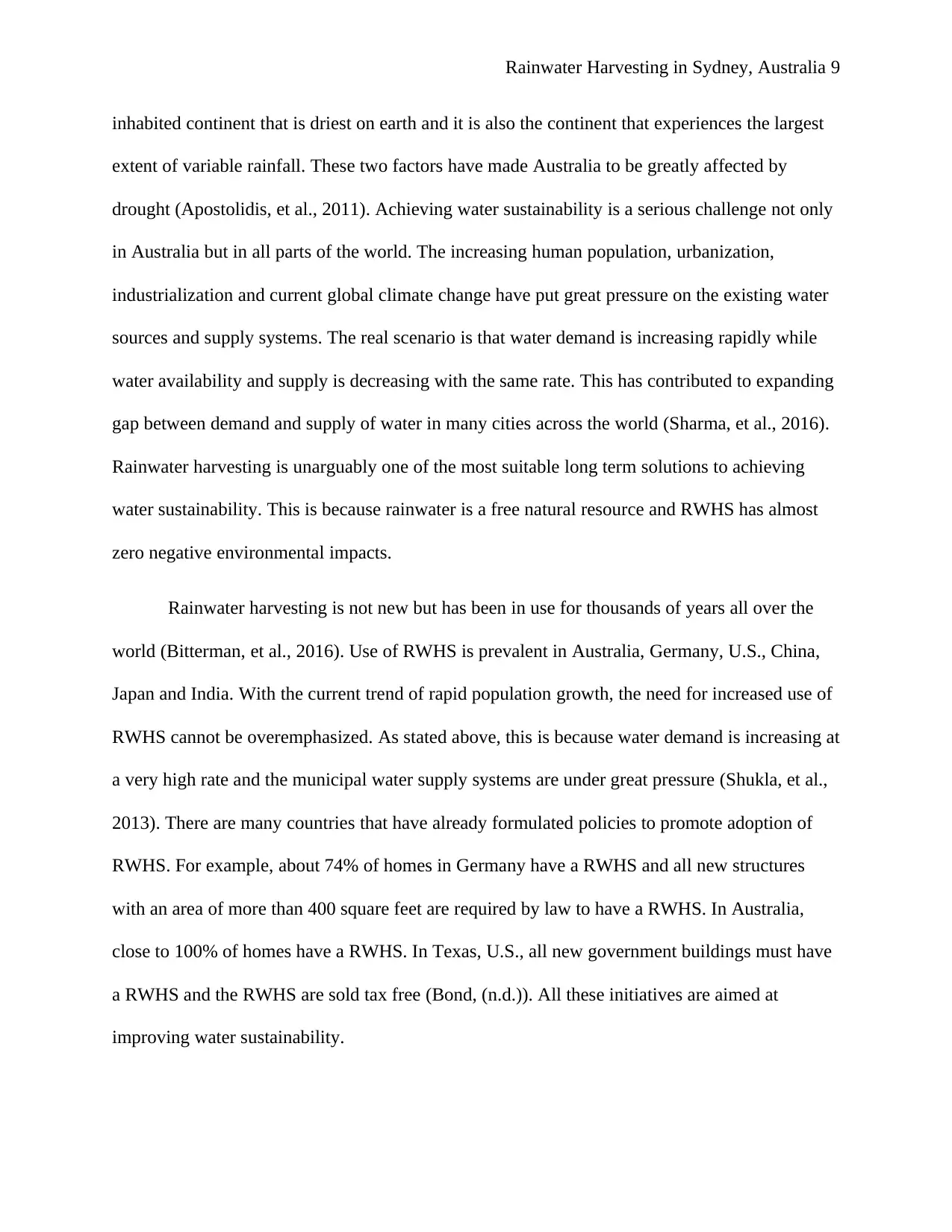
Rainwater Harvesting in Sydney, Australia 9
inhabited continent that is driest on earth and it is also the continent that experiences the largest
extent of variable rainfall. These two factors have made Australia to be greatly affected by
drought (Apostolidis, et al., 2011). Achieving water sustainability is a serious challenge not only
in Australia but in all parts of the world. The increasing human population, urbanization,
industrialization and current global climate change have put great pressure on the existing water
sources and supply systems. The real scenario is that water demand is increasing rapidly while
water availability and supply is decreasing with the same rate. This has contributed to expanding
gap between demand and supply of water in many cities across the world (Sharma, et al., 2016).
Rainwater harvesting is unarguably one of the most suitable long term solutions to achieving
water sustainability. This is because rainwater is a free natural resource and RWHS has almost
zero negative environmental impacts.
Rainwater harvesting is not new but has been in use for thousands of years all over the
world (Bitterman, et al., 2016). Use of RWHS is prevalent in Australia, Germany, U.S., China,
Japan and India. With the current trend of rapid population growth, the need for increased use of
RWHS cannot be overemphasized. As stated above, this is because water demand is increasing at
a very high rate and the municipal water supply systems are under great pressure (Shukla, et al.,
2013). There are many countries that have already formulated policies to promote adoption of
RWHS. For example, about 74% of homes in Germany have a RWHS and all new structures
with an area of more than 400 square feet are required by law to have a RWHS. In Australia,
close to 100% of homes have a RWHS. In Texas, U.S., all new government buildings must have
a RWHS and the RWHS are sold tax free (Bond, (n.d.)). All these initiatives are aimed at
improving water sustainability.
inhabited continent that is driest on earth and it is also the continent that experiences the largest
extent of variable rainfall. These two factors have made Australia to be greatly affected by
drought (Apostolidis, et al., 2011). Achieving water sustainability is a serious challenge not only
in Australia but in all parts of the world. The increasing human population, urbanization,
industrialization and current global climate change have put great pressure on the existing water
sources and supply systems. The real scenario is that water demand is increasing rapidly while
water availability and supply is decreasing with the same rate. This has contributed to expanding
gap between demand and supply of water in many cities across the world (Sharma, et al., 2016).
Rainwater harvesting is unarguably one of the most suitable long term solutions to achieving
water sustainability. This is because rainwater is a free natural resource and RWHS has almost
zero negative environmental impacts.
Rainwater harvesting is not new but has been in use for thousands of years all over the
world (Bitterman, et al., 2016). Use of RWHS is prevalent in Australia, Germany, U.S., China,
Japan and India. With the current trend of rapid population growth, the need for increased use of
RWHS cannot be overemphasized. As stated above, this is because water demand is increasing at
a very high rate and the municipal water supply systems are under great pressure (Shukla, et al.,
2013). There are many countries that have already formulated policies to promote adoption of
RWHS. For example, about 74% of homes in Germany have a RWHS and all new structures
with an area of more than 400 square feet are required by law to have a RWHS. In Australia,
close to 100% of homes have a RWHS. In Texas, U.S., all new government buildings must have
a RWHS and the RWHS are sold tax free (Bond, (n.d.)). All these initiatives are aimed at
improving water sustainability.
⊘ This is a preview!⊘
Do you want full access?
Subscribe today to unlock all pages.

Trusted by 1+ million students worldwide
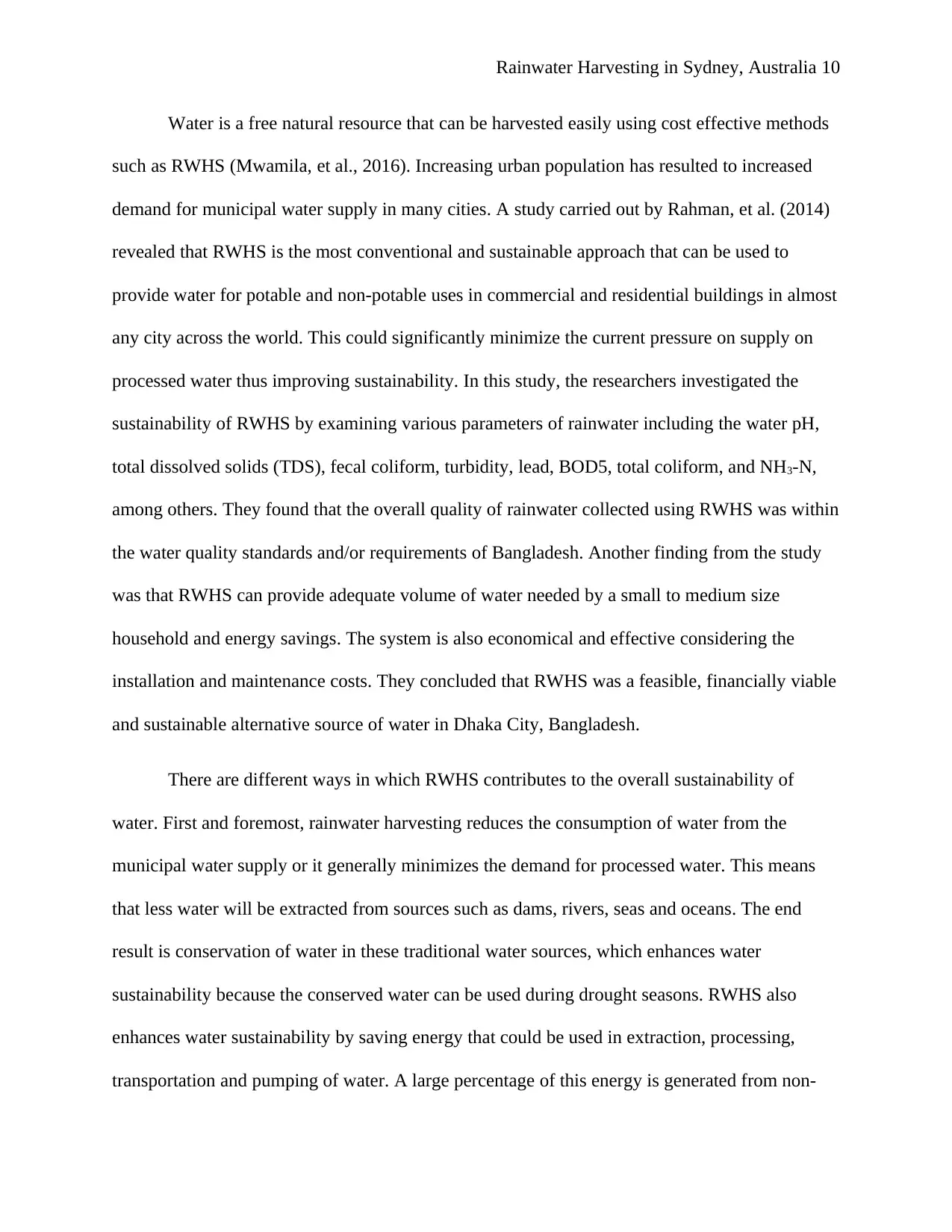
Rainwater Harvesting in Sydney, Australia 10
Water is a free natural resource that can be harvested easily using cost effective methods
such as RWHS (Mwamila, et al., 2016). Increasing urban population has resulted to increased
demand for municipal water supply in many cities. A study carried out by Rahman, et al. (2014)
revealed that RWHS is the most conventional and sustainable approach that can be used to
provide water for potable and non-potable uses in commercial and residential buildings in almost
any city across the world. This could significantly minimize the current pressure on supply on
processed water thus improving sustainability. In this study, the researchers investigated the
sustainability of RWHS by examining various parameters of rainwater including the water pH,
total dissolved solids (TDS), fecal coliform, turbidity, lead, BOD5, total coliform, and NH3-N,
among others. They found that the overall quality of rainwater collected using RWHS was within
the water quality standards and/or requirements of Bangladesh. Another finding from the study
was that RWHS can provide adequate volume of water needed by a small to medium size
household and energy savings. The system is also economical and effective considering the
installation and maintenance costs. They concluded that RWHS was a feasible, financially viable
and sustainable alternative source of water in Dhaka City, Bangladesh.
There are different ways in which RWHS contributes to the overall sustainability of
water. First and foremost, rainwater harvesting reduces the consumption of water from the
municipal water supply or it generally minimizes the demand for processed water. This means
that less water will be extracted from sources such as dams, rivers, seas and oceans. The end
result is conservation of water in these traditional water sources, which enhances water
sustainability because the conserved water can be used during drought seasons. RWHS also
enhances water sustainability by saving energy that could be used in extraction, processing,
transportation and pumping of water. A large percentage of this energy is generated from non-
Water is a free natural resource that can be harvested easily using cost effective methods
such as RWHS (Mwamila, et al., 2016). Increasing urban population has resulted to increased
demand for municipal water supply in many cities. A study carried out by Rahman, et al. (2014)
revealed that RWHS is the most conventional and sustainable approach that can be used to
provide water for potable and non-potable uses in commercial and residential buildings in almost
any city across the world. This could significantly minimize the current pressure on supply on
processed water thus improving sustainability. In this study, the researchers investigated the
sustainability of RWHS by examining various parameters of rainwater including the water pH,
total dissolved solids (TDS), fecal coliform, turbidity, lead, BOD5, total coliform, and NH3-N,
among others. They found that the overall quality of rainwater collected using RWHS was within
the water quality standards and/or requirements of Bangladesh. Another finding from the study
was that RWHS can provide adequate volume of water needed by a small to medium size
household and energy savings. The system is also economical and effective considering the
installation and maintenance costs. They concluded that RWHS was a feasible, financially viable
and sustainable alternative source of water in Dhaka City, Bangladesh.
There are different ways in which RWHS contributes to the overall sustainability of
water. First and foremost, rainwater harvesting reduces the consumption of water from the
municipal water supply or it generally minimizes the demand for processed water. This means
that less water will be extracted from sources such as dams, rivers, seas and oceans. The end
result is conservation of water in these traditional water sources, which enhances water
sustainability because the conserved water can be used during drought seasons. RWHS also
enhances water sustainability by saving energy that could be used in extraction, processing,
transportation and pumping of water. A large percentage of this energy is generated from non-
Paraphrase This Document
Need a fresh take? Get an instant paraphrase of this document with our AI Paraphraser
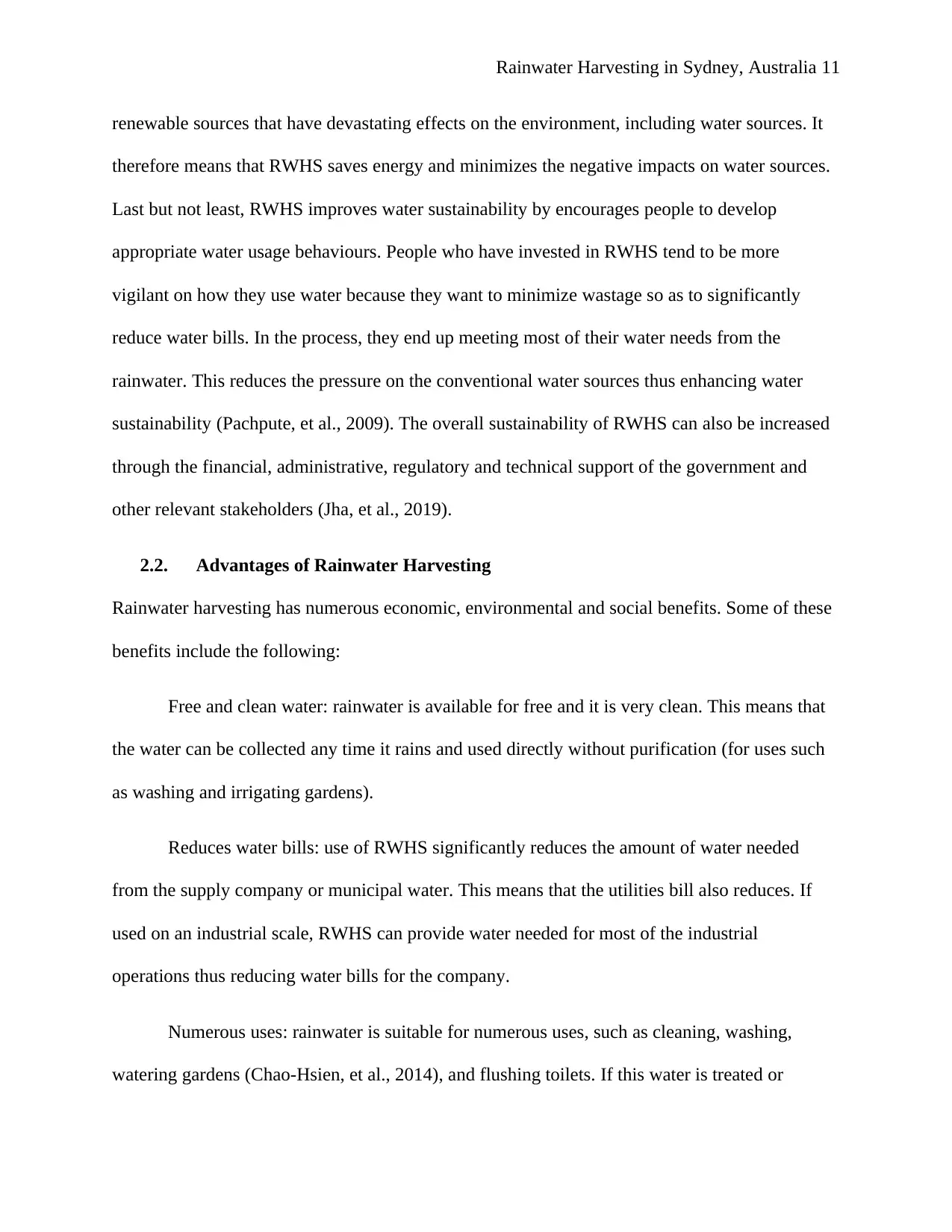
Rainwater Harvesting in Sydney, Australia 11
renewable sources that have devastating effects on the environment, including water sources. It
therefore means that RWHS saves energy and minimizes the negative impacts on water sources.
Last but not least, RWHS improves water sustainability by encourages people to develop
appropriate water usage behaviours. People who have invested in RWHS tend to be more
vigilant on how they use water because they want to minimize wastage so as to significantly
reduce water bills. In the process, they end up meeting most of their water needs from the
rainwater. This reduces the pressure on the conventional water sources thus enhancing water
sustainability (Pachpute, et al., 2009). The overall sustainability of RWHS can also be increased
through the financial, administrative, regulatory and technical support of the government and
other relevant stakeholders (Jha, et al., 2019).
2.2. Advantages of Rainwater Harvesting
Rainwater harvesting has numerous economic, environmental and social benefits. Some of these
benefits include the following:
Free and clean water: rainwater is available for free and it is very clean. This means that
the water can be collected any time it rains and used directly without purification (for uses such
as washing and irrigating gardens).
Reduces water bills: use of RWHS significantly reduces the amount of water needed
from the supply company or municipal water. This means that the utilities bill also reduces. If
used on an industrial scale, RWHS can provide water needed for most of the industrial
operations thus reducing water bills for the company.
Numerous uses: rainwater is suitable for numerous uses, such as cleaning, washing,
watering gardens (Chao-Hsien, et al., 2014), and flushing toilets. If this water is treated or
renewable sources that have devastating effects on the environment, including water sources. It
therefore means that RWHS saves energy and minimizes the negative impacts on water sources.
Last but not least, RWHS improves water sustainability by encourages people to develop
appropriate water usage behaviours. People who have invested in RWHS tend to be more
vigilant on how they use water because they want to minimize wastage so as to significantly
reduce water bills. In the process, they end up meeting most of their water needs from the
rainwater. This reduces the pressure on the conventional water sources thus enhancing water
sustainability (Pachpute, et al., 2009). The overall sustainability of RWHS can also be increased
through the financial, administrative, regulatory and technical support of the government and
other relevant stakeholders (Jha, et al., 2019).
2.2. Advantages of Rainwater Harvesting
Rainwater harvesting has numerous economic, environmental and social benefits. Some of these
benefits include the following:
Free and clean water: rainwater is available for free and it is very clean. This means that
the water can be collected any time it rains and used directly without purification (for uses such
as washing and irrigating gardens).
Reduces water bills: use of RWHS significantly reduces the amount of water needed
from the supply company or municipal water. This means that the utilities bill also reduces. If
used on an industrial scale, RWHS can provide water needed for most of the industrial
operations thus reducing water bills for the company.
Numerous uses: rainwater is suitable for numerous uses, such as cleaning, washing,
watering gardens (Chao-Hsien, et al., 2014), and flushing toilets. If this water is treated or
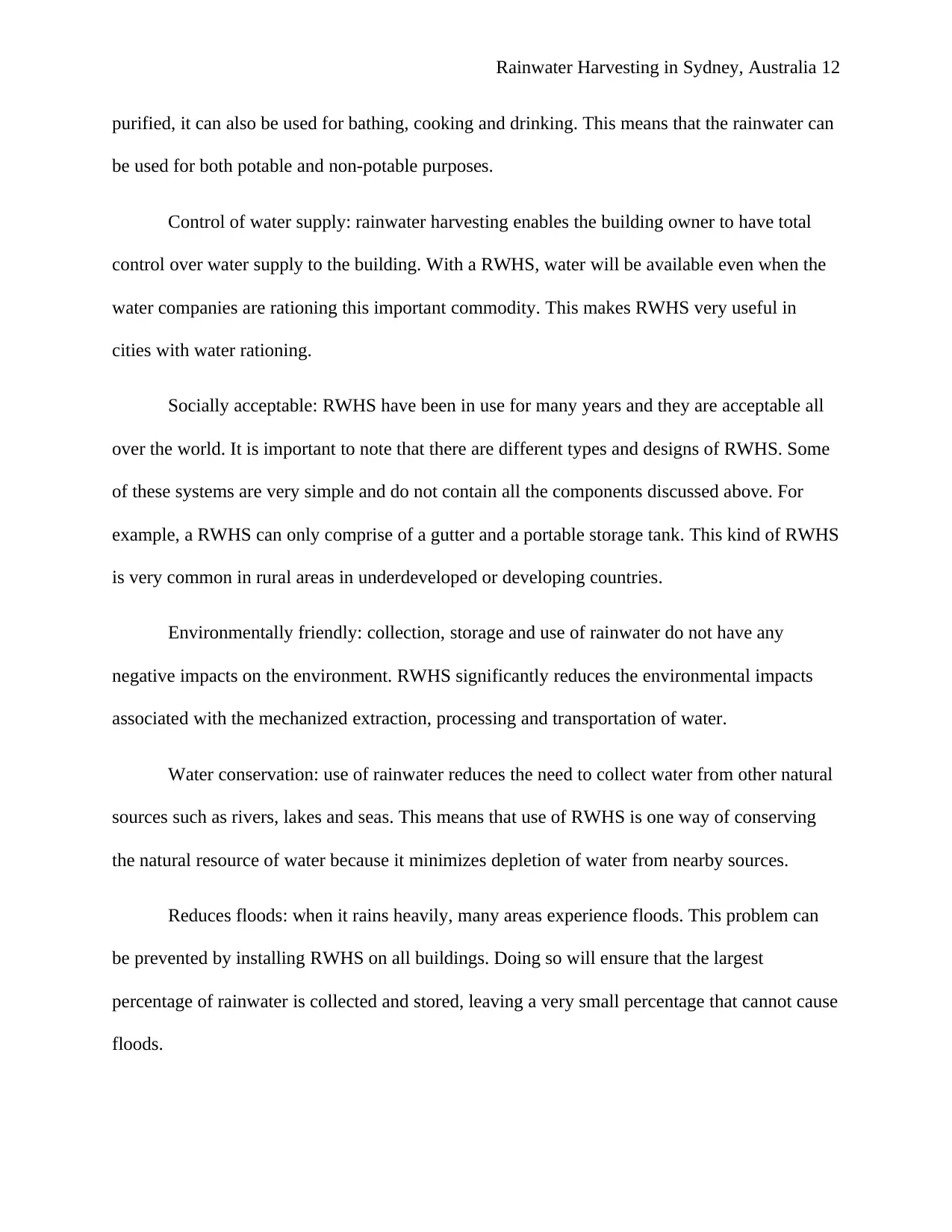
Rainwater Harvesting in Sydney, Australia 12
purified, it can also be used for bathing, cooking and drinking. This means that the rainwater can
be used for both potable and non-potable purposes.
Control of water supply: rainwater harvesting enables the building owner to have total
control over water supply to the building. With a RWHS, water will be available even when the
water companies are rationing this important commodity. This makes RWHS very useful in
cities with water rationing.
Socially acceptable: RWHS have been in use for many years and they are acceptable all
over the world. It is important to note that there are different types and designs of RWHS. Some
of these systems are very simple and do not contain all the components discussed above. For
example, a RWHS can only comprise of a gutter and a portable storage tank. This kind of RWHS
is very common in rural areas in underdeveloped or developing countries.
Environmentally friendly: collection, storage and use of rainwater do not have any
negative impacts on the environment. RWHS significantly reduces the environmental impacts
associated with the mechanized extraction, processing and transportation of water.
Water conservation: use of rainwater reduces the need to collect water from other natural
sources such as rivers, lakes and seas. This means that use of RWHS is one way of conserving
the natural resource of water because it minimizes depletion of water from nearby sources.
Reduces floods: when it rains heavily, many areas experience floods. This problem can
be prevented by installing RWHS on all buildings. Doing so will ensure that the largest
percentage of rainwater is collected and stored, leaving a very small percentage that cannot cause
floods.
purified, it can also be used for bathing, cooking and drinking. This means that the rainwater can
be used for both potable and non-potable purposes.
Control of water supply: rainwater harvesting enables the building owner to have total
control over water supply to the building. With a RWHS, water will be available even when the
water companies are rationing this important commodity. This makes RWHS very useful in
cities with water rationing.
Socially acceptable: RWHS have been in use for many years and they are acceptable all
over the world. It is important to note that there are different types and designs of RWHS. Some
of these systems are very simple and do not contain all the components discussed above. For
example, a RWHS can only comprise of a gutter and a portable storage tank. This kind of RWHS
is very common in rural areas in underdeveloped or developing countries.
Environmentally friendly: collection, storage and use of rainwater do not have any
negative impacts on the environment. RWHS significantly reduces the environmental impacts
associated with the mechanized extraction, processing and transportation of water.
Water conservation: use of rainwater reduces the need to collect water from other natural
sources such as rivers, lakes and seas. This means that use of RWHS is one way of conserving
the natural resource of water because it minimizes depletion of water from nearby sources.
Reduces floods: when it rains heavily, many areas experience floods. This problem can
be prevented by installing RWHS on all buildings. Doing so will ensure that the largest
percentage of rainwater is collected and stored, leaving a very small percentage that cannot cause
floods.
⊘ This is a preview!⊘
Do you want full access?
Subscribe today to unlock all pages.

Trusted by 1+ million students worldwide
1 out of 41
Related Documents
Your All-in-One AI-Powered Toolkit for Academic Success.
+13062052269
info@desklib.com
Available 24*7 on WhatsApp / Email
![[object Object]](/_next/static/media/star-bottom.7253800d.svg)
Unlock your academic potential
Copyright © 2020–2025 A2Z Services. All Rights Reserved. Developed and managed by ZUCOL.




